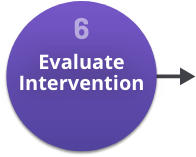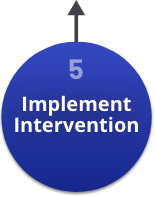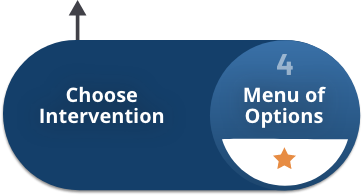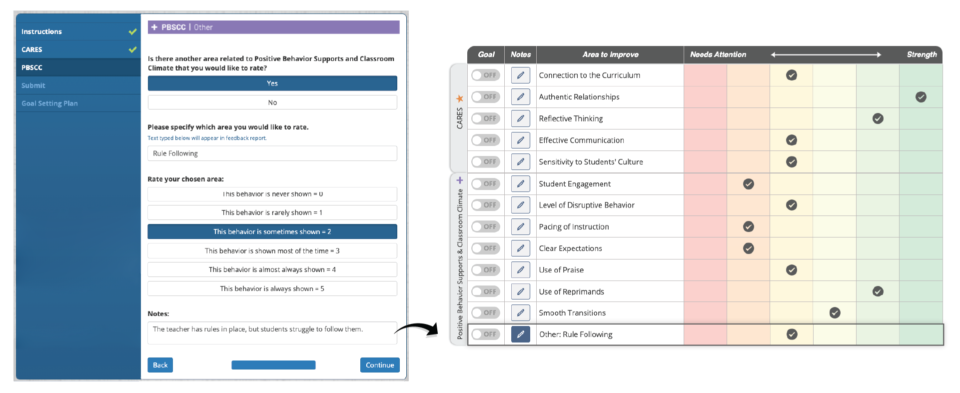Procedure: Assess Classroom
Coaching Process > Assess Classroom
An essential part of the Double Check CCU is to gather objective data about the classroom that can be utilized to guide which strategies will be most useful to apply in the classroom. The data comes from your interview with the teacher, from classroom observation visits that you conduct, and from a discussion around the Teacher Self-Reflection Tool. In this section, you will develop an understanding of the key classroom management and climate variables that are assessed in order to provide useful feedback to the teacher.
You will use all of the information you gather about the classroom to provide the teacher with personalized feedback during the Check-Up meeting. Additionally, you will use the information gathered when the teacher completes the Teacher Self-Reflection Tool to provide a setting for meaningful conversations that will contribute to the development of the goal setting procedure.
There are five elements to gathering accurate and useful classroom information:
How To
Conducting the Teacher Self-Reflection Meeting
Use this link to access the Teacher Self-Reflection Tool and tips on how to successfully facilitate the Teacher Self-Reflection Meeting.
Conducting Classroom Observations
You will conduct several classroom observations to assess several domains of important classroom management and climate. Plan to observe in the classroom for a minimum of 30 minutes (or more) on at least two occasions. Three observational visits are ideal. Arrange to conduct observations during times the teacher reports to be the most challenging times of the day. It can also be helpful to conduct an observation during a time that the teacher reports to be the least challenging. This will help you to look for differences in the way the teacher interacts with students across a variety of settings. If possible, arrange the visits so that you will be able to observe academic instruction, as well as transitions between subjects/content.
The following domains of classroom management will be targeted for observation:
Positive Behavior Supports/Classroom Climate
Setting Up and Beginning an Observation
Setting Up an Observation
Be sure to set up the observation time and day in advance with the teacher. You’ll want to observe during the most challenging times of the day to get a good sense of what is going well and what could be improved. You should plan on visiting the classroom for 30 minutes or more for each observation. During this time, you will want to see both academic instruction and transitions, if possible.
Describe to the teacher the purpose of the observation and what you will be looking for in the classroom.
When you enter the classroom, do so discreetly as previously discussed. You may want to ask the teacher if the time still works for you to visit. Find an unobtrusive location in the classroom that allows you to view the teacher, students, and classroom setup.
Begin by scanning the classroom, making note of the physical layout of the room, noticing any areas of the room that are cluttered or where students may not be able to view the teacher. Look for posted classroom rules and a daily schedule and determine how materials are organized. If you need to walk around the room, do so quietly without interrupting normal activities in the classroom. Refrain (as much as possible) from getting into discussions with students.
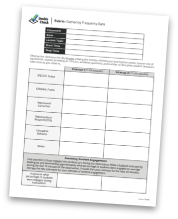
Additionally, you will want to use the Double Check CARES Data Collection form to collect information related to each of the CARES Domains: Connection to the Curriculum, Authentic Relationships, Reflective Thinking, Effective Communication, and Sensitivity to Students’ Culture. Make notes to describe specific evidence of these domains being present or absent in the classroom.
If you are good at multitasking, you may tally frequency data and make note of the CARES domains at the same time. If not, wait until you have gathered 20 minutes of frequency data before using the CARES Data Collection form.
You may want to have a clipboard with you to hold the rubric as you score. Make notes as needed on the rubric form to allow for useful and accurate scores.
Gathering Frequency Data
Praise
- What is it?
- Teacher approval of desired student academic or social behaviors.
- Two types:
- General: praise statement that does not provide specific feedback (e.g., “Good job,” “Nice work”).
- Behavior specific: praise statement that tells the student or students the behavior for which they are being praised (e.g., “Thank you for raising your hand(s)”).
- Why is it important?
- Praise reduces off-task and disruptive behaviors and increases instructional time.
- Behavior-specific praise makes teacher expectations clear, increases student motivation and sense of competence, and has the biggest benefits for reducing problem behaviors in the classroom.
Reprimands
- What is it?
- Teacher comments or gestures made by the teacher indicating disapproval of student behavior.
- Why is it important?
- Sets the emotional tone and climate of a classroom.
Ratio of Interactions
- What is it?
- The number of positive to negative interactions in a classroom.
- Usually calculated as the number of total praise statements to reprimands in a given period of time.
- Why is it important?
- Higher rates of positive to negative interactions lead to more positive teacher-student relationships, higher rates of student compliance, and fewer classroom disruptions.
- Well-functioning classrooms have positive to negative ratios of 3:1 or better.
Opportunities to Respond (OTR)
- What is it?
- Any time a teacher requests students to answer an academic question.
- Why is it important?
- Increasing the rates of opportunities for responding during instruction generates more learning, provides important feedback to the teacher, and increases on-task behavior.
- Goal: 4-6 per minute for new material; 9-12 per minute for drill and practice.
Student Disruptions
- What is it?
- Statements or actions of an individual student or group of students that interfere with ongoing classroom activities.
- Why is it important?
- Disruptions interfere with instruction and cause stress for teachers and students.
- Tracking disruptions is a good tool for monitoring whether classroom management strategies are working.
Classwide Student Engagement
- What is it?
- A snapshot of what percentage of students are on-task during a given period of time.
- Why is it important?
- Student engagement provides an indication of student interest in instructional content and activities.
- Low student engagement can be addressed through changes in instructional pacing and design.

Use the form on the front of the Double Check Classroom Assessment Rubric to count the frequency of praise, reprimands, opportunities to respond, student disruptions, and classwide student engagement.
Connection to the curriculum refers to the way that teachers are able to bring students’ diverse backgrounds into lessons and the classroom while minimizing instances of ethnic stereotyping.
When gathering evidence of connection to the curriculum, important indicators to note are 1) whether the teacher uses a variety of teaching modalities and activities to engage all students; 2) whether students are represented in the classroom through displays of work and areas of interest; 3) whether students play active roles in the classroom and learning process; 4) if the teacher encourages and solicits different viewpoints without judgment; 5) whether the teacher asks higher order questions equitably across the classroom; 6) if displays in the classroom include people of color in a broad range of professional roles; and 7) whether the teacher connects their content to real-world experiences of their students in a meaningful and engaging way.
When observing in the classroom, consider how connection to the curriculum may be optimized:
- Students are clearly a part of the decision-making process for how the classroom is organized and ways in which the content is taught.
- Grouping students in multiple ways can allow for greater connection between classmates and the different perspectives they have.
- Students are encouraged to take on a variety of leadership roles within the classroom.
- When students are provided with an opportunity to share what they would like to learn and how, they feel more connected to the curriculum and classroom in general.
- When teachers allow students to provide critical feedback and input on the design of the classroom and lessons, students feel more ownership.
Authentic relationships refers to the genuine respect and care that a teacher demonstrates for each one of their students. This encompasses how well a teacher knows each student personally and academically and the types of interactions they engage in with each. Teacher-student interactions should not all be centered only on academics, but rather be noncontingent in nature and enhance a positive relationship between teacher and student. This may extend to how much a teacher knows about the families of their students, as well.
When gathering evidence of authentic relationships, important indicators to note are 1) whether the teacher engages in conversations with all students that go beyond academics; 2) whether the teacher shares an appropriate level of personal information with their students; 3) if the teacher uses a variety of methods to engage with students based on how well the teacher knows the learning modalities of each student; and 4) whether a teacher uses active listening skills when talking with students in an effort to better understand what motivates each student.

When observing in the classroom, consider how authentic relationships may be optimized:
- Students are eager to share good news with the teacher and the teacher reciprocates with good news of their own.
- There is obvious mutual respect between the teacher and all of their students evident in the way that the teacher and students can navigate challenging situations.
- When a teacher can have fun with their class while also providing an environment with high expectations for learning, students will rise to meet those expectations and will seek help and assistance from the teacher when needed.
- Teachers who make an attempt to know and understand the families of their students without passing judgment demonstrate genuine care.
Reflective thinking refers to how a teacher engages in thinking about their own cultural group memberships as well as the cultural group memberships of their students and ways in which their beliefs and actions perpetuate stereotypes and inequities. While this is sometimes harder to observe directly in a classroom, there are still some indicators that can provide clues as to ways in which a teacher’s actions may impact students in a negative or inequitable way.
When gathering evidence of reflective thinking, important indicators to note are 1) whether the teacher admits to mistakes made in regards to the way they may have handled a situation; 2) whether the teacher places blame on students for behaviors the teacher does not appreciate; 3) whether the teacher examines the function of behaviors rather than the result of the behavior; and 4) whether the teacher pauses before responding at times when a more thoughtful response is warranted.

When observing in the classroom, consider how reflective thinking may be optimized:
- Teachers who actively try to understand differences and value them as opposed to looking at differences as deficits will demonstrate their willingness to allow students to freely express their own identities.
- Teachers can model for students how to admit when they have made a mistake and provide a platform for students to share in that discussion.
- Teachers reach out and offer support to students who may need extra help in a way that is not punitive but is instead collaborative.
- Student strengths are known for each individual student.
Effective communication refers to all the ways that a teacher relays information to students, verbally and nonverbally. This includes communicating academic and behavioral expectations to students as well as acceptance and disapproval. The better a teacher knows their students, the more they can tailor their communication to be more effective overall.
When gathering evidence of effective communication, important indicators to note are 1) whether the teacher communicates in a variety of ways to students; 2) whether the teacher acknowledges behaviors they want to see more of in a positive way; 3) whether a teacher provides praise and expresses acceptance to all students equitably; and 4) whether the teacher is able to manage their emotions when communicating through a challenging situation.

When observing in the classroom, consider how effective communication may be optimized:
- Students are provided with behavior-specific praise equitably and often.
- When a teacher provides praise to students, it is genuine.
- A teacher varies the way they provide praise to students (i.e., publicly vs. privately) based on how well they know each student.
- A teacher can share their frustration with students in a way that demonstrates that they are still in control of their emotions and their own behaviors while effectively expressing their feelings.
- Students are provided with multiple ways to respond and engage in the classroom (e.g., choral responses, raising of hands, written responses).
- Teachers demonstrate their willingness to receive feedback.
Sensitivity to students’ culture refers to how well a teacher recognizes that students from culturally and linguistically diverse backgrounds may behave and engage in ways that are different than what the teacher may be used to and that those differences are not equivalent to a deficit. Understanding the individual culture each student brings with them will help teachers to respond in culturally responsive ways.
When gathering evidence of sensitivity to students’ culture, important indicators to note are 1) whether the teacher makes an effort to connect with the school community and neighborhoods; 2) whether the teacher uses purposeful grouping and/or seating to optimize and enhance the strengths of each student as well as to create a positive classroom community; 3) whether the teacher examines and reviews their curriculum to look for instances of stereotypes and negative cultural images; and 4) whether the teacher encourages students to share parts of their own cultural identities to promote a culturally diverse climate.

When observing in the classroom, consider how sensitivity to students’ culture may be optimized:
- Teachers help students to understand the message that is being conveyed through various behaviors, especially in instances where there is a problem or conflict between students or with the teacher.
- Students are asked to contribute to the classroom lessons and classroom structure.
- Students are placed into a variety of groups instead of being partnered or grouped regularly with the same students.
After gathering frequency data during the 20-minute observation, score the rubric using the information you gathered to inform your scores.
You will want to review the Double Check Classroom Assessment Rubric in advance of beginning an observation. Become familiar with the layout and how each observational domain operationalizes the subsequent areas within each domain. The rubric is set up so that higher scores are better.
Areas receiving a “5” have all indicators in place and demonstrate an area of strength (green zone). Areas receiving a “3” have some indicators missing or not in place, demonstrating that this is an area that could use improvement (yellow zone). Areas receiving a “0” have little to no indicators in place and are areas in need of attention (red zone).
Following scoring each indicator within the area, determine the best overall score for that area. For instance, the best overall score for use of praise in the example above would be a “3,” or in the yellow as more of the indicators fell into this range. The indicators provide guidance to what you determine to be the best overall score for that observation. Notice for praise, that if no praise is provided, the observation earns a score of “0.”
The following breaks down scoring the rubric for the two additional domains within the Positive Behavior Supports/Classroom Climate area that are not assessed through the frequency data collection.
When scoring clear expectations, important indicators to observe are 1) whether the behavioral expectations are clear not only to students in the classroom, but also to visitors; 2) whether students have a clear understanding of the behavioral expectations; 3) whether the teacher reinforces behavioral expectations; 4) whether the teacher reviews behavioral expectations regularly; 5) if there is consistency in the way rules and routines are implemented; and 6) the quality (e.g., specific, positively stated, and observable) of classroom routines.
When observing in the classroom, consider how classroom expectations may be optimized:
- Effective classroom rules are positively stated, specific, observable, and concise.
- Students display the expected behavior because the rules have been taught and reviewed as needed.
- Practicing the rules is helpful, particularly when large numbers of students are not displaying the expected behaviors.
- Teacher gives a lot of behavior-specific praise and positive attention to students for following the rules.
- Classroom rules are consistently enforced by the teacher.
- Routines work best when the behavioral expectations for each routine are defined so that they are developmentally appropriate, culturally responsive, positively stated, specific, and observable.
- Students learn routines when they are explicitly taught and reviewed.
- The teacher provides positive attention to students when they effectively demonstrate the routines using praise or rewards.
- Having visual prompts of the classroom routines displayed is very useful, keeping each routine to the fewest steps possible.
When scoring smooth transitions, important indicators to observe are 1) whether the teacher provides a prompt to begin the transitions; 2) whether the teacher tells the students what the transition should look like prior to having the students transition (precorrection); 3) whether or not the teacher used a signal to gain the students’ attention and if the students understood the attention signal; 4) whether the routines used during the transition are efficient; 5) the amount of time the transition takes; 6) the level of disruptive behavior during the transition and whether the teacher has to redirect the students; and 7) whether the teacher provides attention (e.g., behavior-specific praise) to students who transition smoothly.
When observing in the classroom, consider how classroom transitions may be optimized:
- Smooth transitions use efficient routines that quickly get students to the next task, losing little time for instruction.
- Teacher explicitly teaches students how to transition smoothly and provides practice, as needed.
- Teacher uses effective attention signals, which are taught to students to gain their attention before transitions begin.
- Teacher provides precorrections to tell students exactly what to do prior to a transition occurring.
- Teacher provides behavior-specific praise to students as they transition smoothly to the next task.
Once you complete the Feedback Survey, a feedback form for that teacher will populate and be ready for review (above on right). You will want to review the feedback form in advance of meeting with the teacher. As you review the feedback with your teacher, use examples from your observation to inform the discussion.
To review the feedback form, go to the My Teachers page and click on the Check-Up Feedback button for your teacher.
Reflection & Tips:
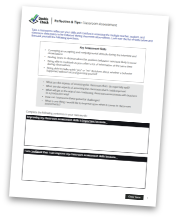
References to Other Relevant Resources:
Reinke, W., Herman, K., & Sprick, R. (2011). Motivational interviewing for effective classroom management: The classroom check-up. New York, NY: Guilford Press.
Sprick, R. (2009). CHAMPS: A proactive and positive approach to classroom management. Eugene, OR: Pacific Northwest Publishing.


